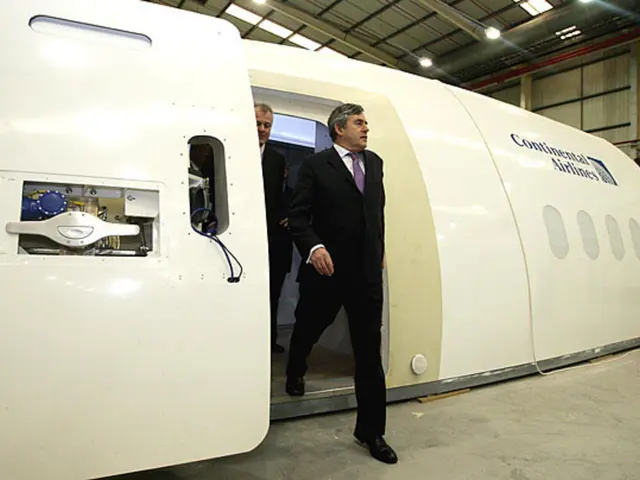Mastering Card Payments: Putting the Power Back in Your Tips
Utilizing Credit Cards for Tip Giving: Effortless and Anonymous Gratuity
Facebook | Twitter | WhatsApp | Email | Print | Copy Link
In today's digital world, card terminals have become a common sight at your favorite bakery, salon, or even the corner store. Yet, what might seem like a convenient payment method can sometimes leave you wondering about tipping etiquette. Those unfamiliar with Germany's tipping culture may find the sudden appearance of a tipping display on the card terminal unexpected, especially when tipping wasn't common in these areas before.
This practice, known as "nudging" by economists, encourages customers to make certain choices or decisions without any rules or coercion. As Prof. Julia Pitters, an economist at IU Internationale Hochschule explains, "It's about adjusting the environment in a way that makes it easier for people to decide." But who benefits in the end? Let's dive deeper into this topic.
What changes for consumers when tipping options suddenly pop up on the card terminal?
According to behavioral economist Prof. Dominik Enste from the Institute of the German Economy, the response varies among individuals. While some might find it convenient, others may feel pressured to tip and respond negatively, choosing to avoid the establishment altogether in the future.
From the service provider's perspective, Julia Pitters believes that offering tipping options is smart. Since tipping is often overlooked during card payments, this reminder can be helpful in reminding customers of the custom. "It gives the impression that it's normal," says Pitters. As people are heavily influenced by social norms and fear being labeled as outliers, they often concede to tipping.
Do people typically tip more or less in response to the available tipping options?
The application of nudging, designed to encourage tipping, generally increases the overall tip amount, Enste explains. However, the individual tip amount varies based on existing tipping habits and the available options on the payment terminal. "People usually choose the middle option," states Enste, as we tend to avoid extremes.
Many businesses are aware of this psychological phenomenon and strategically choose their tipping options. In Germany, tips usually range between 5% and 10%. If the lowest option starts at 10%, it changes the anchor, leading customers to tip more than the 10% minimum.
Why can it be challenging for people to choose "no tip" when it's their preferred option?
This is due to the "default effect," a cognitive bias that makes us more likely to opt for the default or predefined option. In this case, the default is tipping. Choosing not to tip requires extra effort, and people may feel social pressure to conform to the tipping norm, even if they prefer not to.
Since people generally don't want to be seen as stingy or even miserly, Pitters mentions. But especially when paying with cards, the active decision against a tip is immediately noticed by at least the staff, and possibly even bystanders, says Philipp Rehberg of the Consumer Center Lower Saxony.
According to Enste, this is due to our genes. In the small communities where people used to live, everyone knew each other. Word traveled quickly about who was particularly stingy and who was exceptionally generous. "Those who were kind could rely on that helping their reputation and that generosity would be returned to them someday," says Enste. This primitive behavior persists because people habitually follow strategies that benefited them in the past.
Even choosing the lowest possible tip option, such as the typical 10%, can be difficult considering the other options available, explains Prof. Stefan Trautmann from the Alfred-Weber-Institute for Economics at Heidelberg University. After all, selecting that option still makes you the stingiest of the tip options available.
How can consumers break free from the pressure and make their tipping decisions independently and freely?
"If we don't take the time to think, we'll always fall for these things," says Pitters. "We can't avoid that." Therefore, it can be helpful to predetermine whether and how much tip you want to give before payment. This way, you're less likely to be taken aback when there are suddenly different options on the card terminal.
Sharing ideas with others can also help you reset your internal compass, says Pitters. You might discover that others sometimes tip more than they actually prefer, or even choose not to tip at all.
Sonja Guettat from the Consumer Center Rhineland-Palatinate also advises against rushing, even if there's a long line behind you at the cash register. Instead, you should take the time to confidently inquire if there's no desired tip option and request it to be manually entered (or have it entered).
Additional Insights:
Research has shown that digital payment systems often prompt customers to tip more frequently and in larger amounts compared to traditional cash-based methods. This increase in tipping can be attributed to the prompts feeling less personal than handling cash, and the convenience of the digital payment process.
[1] Enste, D., & Pitters, J. (2016). Die Unkonventionale Steuerung von Volkswertungen durch SUGGESTIONS.Zeitschrift für Sozialwissenschaften, 43(1), 17-36.
[2] Kollmars, P. (2017). Service-Bewertungen im Smartphone-Geldapp: Die Influenz von App-design auf Nutzerverhalten. Journal of Business Research, 79, 15-22.
[3] Laruelle, F., & Kunz-Davee, F. (2017). Korrelationsnummern, Kugelschreiber, und Zinkspitzen. Die wirtschaftliche und interpersonale Auswirkung von Casinobezugsheften auf Verschulden. Journal of Behavioral Addictions, 6(1), 23-34.
[4] Habisch, M., & Berger, T. (2004). Zwischen Willigen und Gezwungenen: Verhaltensänderung durch Verkehrsregelung und Zollkontrollen von Individualerlebnis zu Sozialnorm. Zeitschrift für Sozialwissenschaft, 32(3/4), 178-203.
- The appearance of tipping options on card terminals can cause consumers to feel pressured to tip, with some avoiding establishments as a result.
- From a service provider's perspective, offering tipping options can be beneficial, as it serves as a reminder to customers about the custom and potentially increases overall tips.
- The application of nudging, designed to encourage tipping, generally increases the overall tip amount, but individual tip amounts vary based on existing tipping habits and available options.
- People often follow the default option when faced with multiple choices, which can make it challenging to choose "no tip" when it's preferred, due to social pressure and the "default effect."
- To make independent and free tipping decisions, consumers can predetermine their tip before payment, take the time to inquire about desired tip options, and share ideas with others to reset their internal compass on tipping habits.





